One Friday evening earlier this summer we enjoyed a lovely supper at our friends Michelle and Bill’s house out in East Royalty. Returning home after supper we were in kind of a rush, as Oliver and I had plans to take in an Island Fringe show. Add to this rush that it was hot (and that our car has no air conditioning), that Ethan spotted another dog as I pulled into our driveway and was barking uncontrollably, and that there was a gaggle of young hipsters chilling on the porch next door, and I was not at my driverly best.
It was at this point that passenger side mirror met eavestrough. You can see the evidence still:
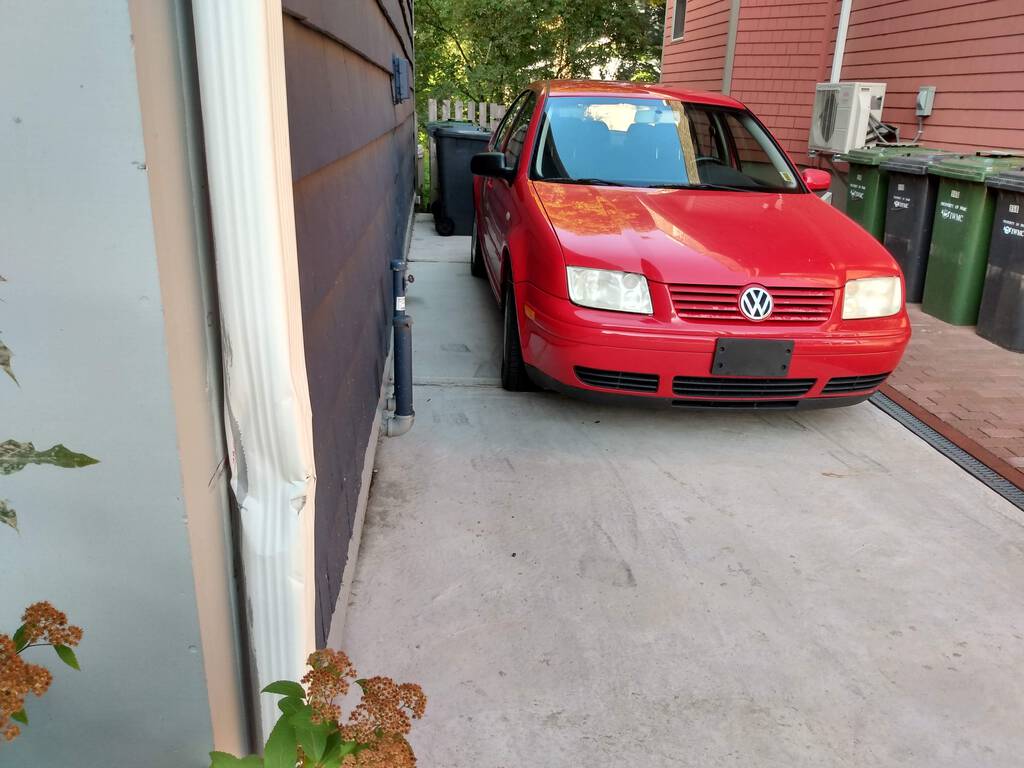
It’s remarkable that, in 19 years of backing this car into this driveway with this eavestrough located where it is that I hadn’t done this sooner: it was an accident waiting to happen.
By some miracle I didn’t rip the eavestrough right off the house; indeed it suffered very little damage, and young Henry from next door was able to make quick work of unmangling it before I even exited the car.
Otherwise the damage was limited to my pride, and to the destruction of the sideview mirror, which I carefully removed once I’d retained my cool. Here’s the mirror, deconstructed:
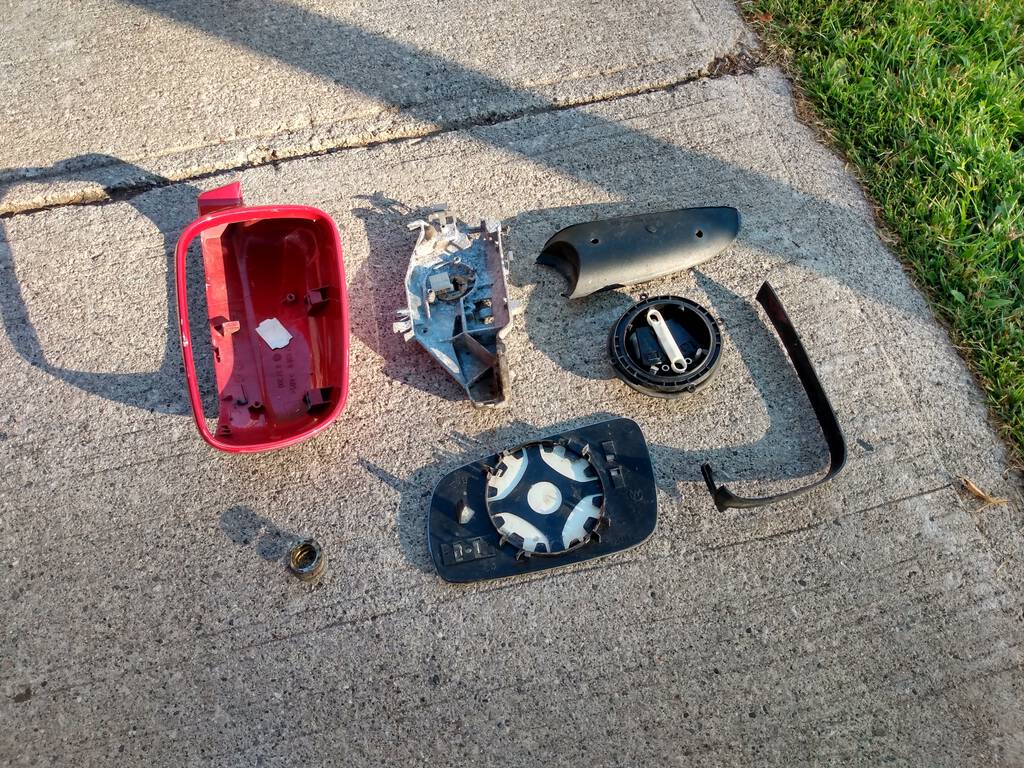
Replacing the mirror turned out to be a lot easier than I thought: I was able to order an aftermarket replacement from Amazon for $66.27, taxes and shipping in:

The mirror assembly arrived a week later, and I followed the helpful instructions in this YouTube video to install it. I had all the tools that I needed for the job, save the T45 Torx driver that’s used to remove the large bolt that holds the mirror itself; T45 Trox drivers are, apparently, rare birds, as Home Hardware had none, and Canadian Tire, in its wide range of Torx sets, had only one that included a T45. So I bought that set.
Once I had the T45, the only tricky part was getting the door to snap back into place via the plastic clips that hold it on: the clips were in various states of decay (the car, after all, is 20 years old), and sproinged off or got crushed in my early ham-handed attempts at reattachment. So I’ll make a visit to the VW dealer this afternoon to purchase some replacements. But in the meantime, I have a new mirror:
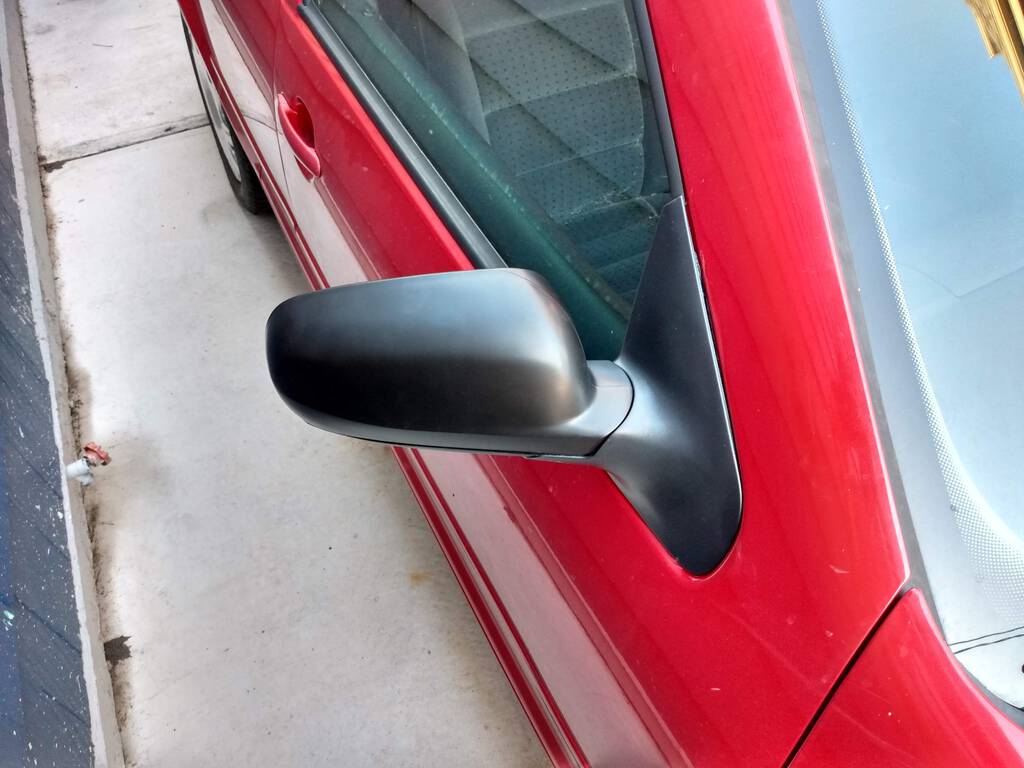
The replacement mirror, despite only costing $57, has all the functionality of the original: it’s heated (for defrosting in winter), and can be controlled remotely from the driver’s side mirror controls.
I’d rather this hadn’t happened at all, but I’m happy to have been able to repair the car myself, and those in my right-hand blind spot should feel slightly safer now that I can see them a little better.
On August 15, 2019, T3 Transit Bus 68 started its day just after 6:30 a.m. servicing Route № 3, the route that goes counter-clockwise around the city from downtown through Parkdale, Sherwood, Hillsborough Park, and West Royalty.
For the next 12 hours it drove a total of 245 km, servicing both Route № 3 and, on occasion, Route № 1.
Here’s what its day looked like, compressed down to 2 minutes:
Oliver and I caught the bus at 4:38 p.m. at the corner of Beach Grove and Maypoint Road; it was running about 8 minutes late. It made up a lot of that time, and dropped us downtown 10 minutes later, close to on-time, at 4:48 p.m.
Bus 68 finished up its day just before 7:00 p.m., with one final counter-clockwise run around the city. It then headed back to the garage for the night before starting back again, just after 6:30 a.m., the next morning.
How I Made This
I pulled real-time bus location information from the T3 Transit ReadyPass map. This gave me 2,258 time-stamped bus position points in a CSV file, like:
logTime,busNumber,routeNumber,lat,long,cellStrength,speed,updateTime,accuracy,battery
2019-08-15 06:37:43,68,3,46.234024047852,-63.12748336792,0.019,0,2019-08-15 09:37:42,58,244
2019-08-15 06:37:59,68,3,46.234027862549,-63.12748336792,0.019,0,2019-08-15 09:37:53,49,244
2019-08-15 06:38:14,68,3,46.234027862549,-63.12748336792,0.018,0,2019-08-15 09:38:10,42,244
I imported these points into QGIS and used the TimeManager plug-in, with interpolation set to “Linear interpolation for big datasets” and a time frame size of 15 seconds. I exported the resulting frames to PNG files and then combined the 2,926 frames into a single MP4 video with ffmpeg:
ffmpeg -i frame%5d.png -movflags faststart -pix_fmt yuv420p -vf "scale=trunc(iw/2)*2:trunc(ih/2)*2" video.mp4
I can watch the resulting video over and over and over: it’s like a transit ballet. Or a transit video game.
In a way that keeps one foot in each of North American and European café billing practices, Island Chocolates sometimes takes money up front for coffee, and sometimes advises “just take a seat,” with the implication one should pay afterwards.
Walking in the front door this afternoon, on my weekly break while Oliver is making art with Jennifer Brown, I suddenly realized that two weeks ago things had gone in the “have a seat” direction but that I hadn’t actually paid on the way out.
I penitentially declared my sin at the cash today, and was thanked for my honesty.
Oliver and I cycled the entire Local Food Trail this morning: from home to the Charlottetown Farmers’ Market, down to Purity Dairy for milk and butter, a double back to Riverview Country Market, and then to Receiver Coffee Brass Shop for bread.
Oliver was much more comfortable on his bike this morning, zipping along beside me and sometimes overtaking. Every time we met oncoming cycle traffic he rang his bell in solidarity and gave a hearty “good morning.”
The only debacle, and it was a minor one, was that the hex bolts that hold my handlebars on came loose as we headed homeward through Joe Ghiz Park. I had high hopes that I’d be able to use the bicycle repair station in the park to get myself sorted, but the hex key, if it was ever there, had been vandalized off.
Fortunately, as we entered the Water Street gravel storage lot to loop around to Receiver, we encountered more professional-grade cyclists, and I was able to borrow a hex set and tighten things up.
You wanna know the greatest thing about cycling to the market? It’s not the carbon we’re not emitting, it’s not the exercise, it’s not our membership in the grand fellowship of cyclists (although all those things are great). It’s that Oliver and I can do it together. Cycling is an inherently social practice in a way that driving a car is not.
Given that Oliver has been cycling for only three weeks, and that he’s naturally taken to this new mode of getting around on Saturday morning, I feel confident that I can say to you that if you live in Charlottetown and you’re still driving your car to the market, you’re doing something wrong.
Please consider following his lead: confront the innumerable reasons you will inevitably come up with for why you can’t possible not take your car, get your bicycle out of the shed, and join us on the trail next Saturday.
When Oliver and I were in Wolfsburg in 2010, we visited Phaeno, the excellent science museum. One of the exhibits there was an “age machine” that would snap a photo of you and apply an algorithm that would project your appearance in the future; it’s a technology that’s now reached our phones via FaceApp.
This photo, by Daniel Burka, featured in this photo montage of silverorange’s 20th anniversary, looks like I’ve been through the age machine filter, but it’s really just the way I look at age 53 (Oliver’s youthful countenance beside me only serves to accentuate my oldness) .

My father and I look nothing at all alike, but I realize, looking at this photo, that the topography of our aging is similar. I can also see hints of my mother, and of my grandparents, on both sides.
Life itself is the ultimate age machine, so perhaps rather than recognizing my actual ancestors, all I’m really seeing is getting older as it’s universally expressed.
There was an electricity outage last night from Charlottetown east, starting just before 11:00 p.m. and ending around midnight. Because I’m logging the electricity load and generation for the province, this outage got captured in the data:
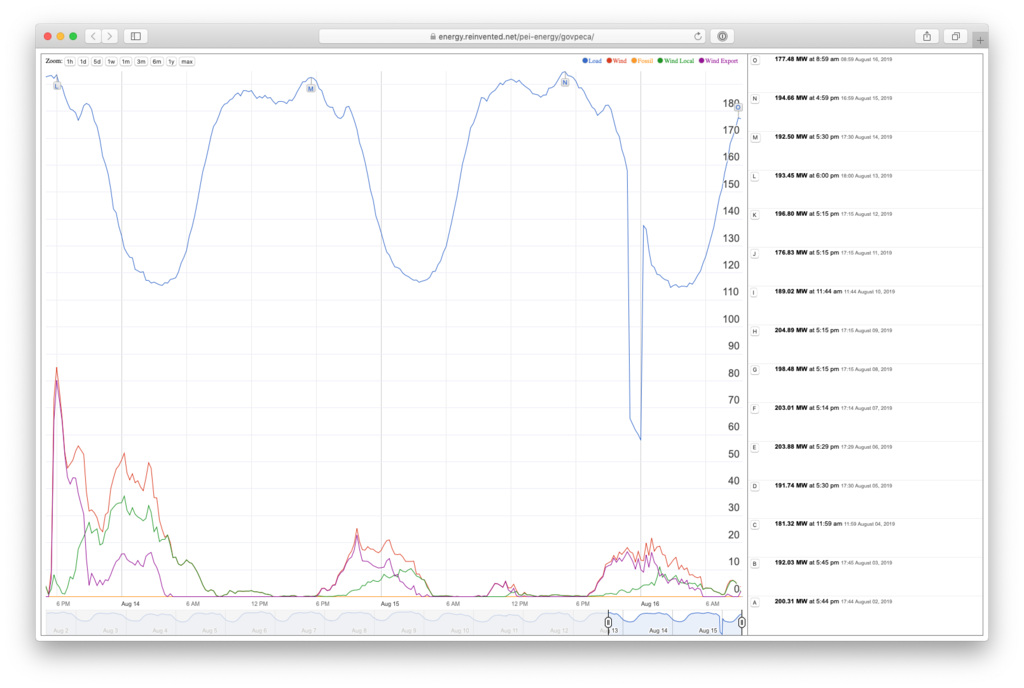
Electricity load dipped to 58 MW at midnight; the night before at midnight the load was 135 MW.
If you are looking for some inky collegiality this Saturday night, August 17, 2019, Pen Night, the monthly gathering of those interested in fountain pens, inks, paper, writing, illustrating and the related arts, is happening at 7:00 p.m. at The Bookmark.
All that’s asked, if you’re planning on coming, is that you RSVP so that a chair can be set aside for you.
You need not be a pen nerd to attend, nor even own a fountain pen: we’re a welcoming bunch and if you show up penless and curious you will likely emerge equipped for a life of fountain pen-loving.
Like the original the fifth estate and e e cummings, my friends at silverorange prefer lowercase. Which makes starting sentences that start with silverorange difficult for someone like me who wants to follow both silverorange’s rules and society’s.
A conundrum I avoid simply by avoiding starting sentences with silverorange.
I have known the founders of silverorange from before they were silverorange; in some cases I’ve known them since they were 14 years old. Now they are at or approaching 40, and I have been, by times, their tenant, their conference co-organizer, their lunch companion, and their partner-in-podcasting. And, as individuals, their friend.
Their company turned 20 years old yesterday, and they celebrated with an event for friends, family, colleagues and clients at Brakish; here’s a soggy audience listening to various of the founders talk about their relationship to the company:
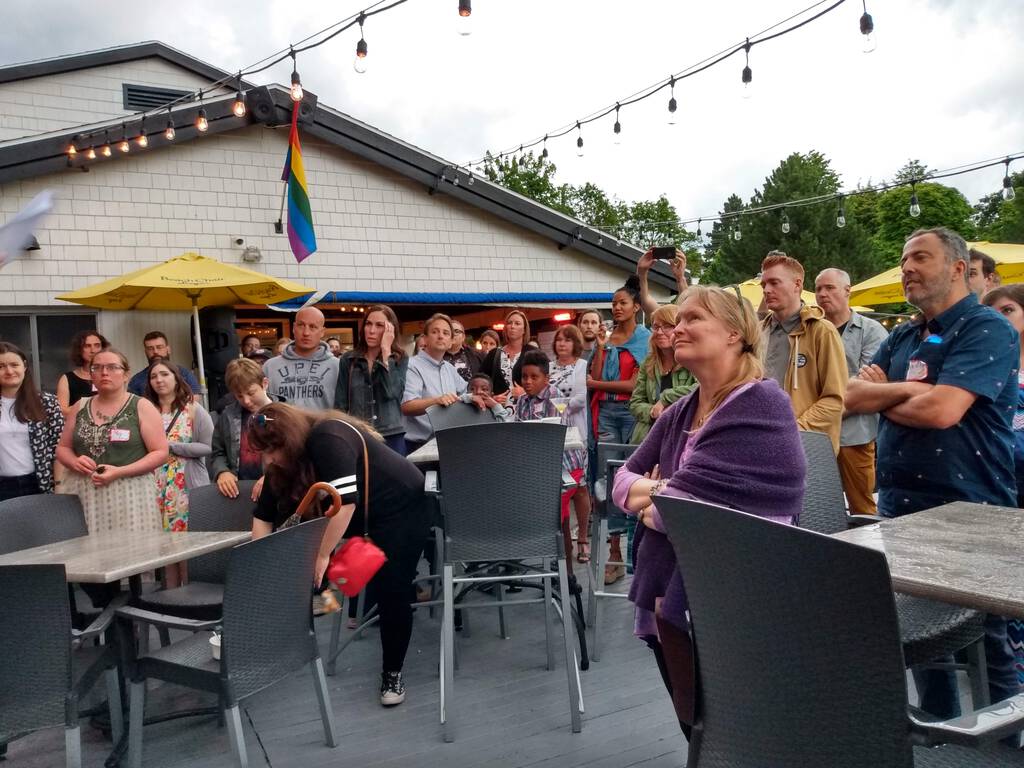
Being in close proximity to silverorange for such a long time has been a unique privilege: I have watched as they transformed from the chrysalis of cocky teenage entrepreneurship into the butterfly of a well-managed, well-respected company.
Silverorange (damn, I slipped) is perhaps most remarkable for the cultural transformation it’s gone through in recent years, seeking to throw off the toxic masculinity of the ironic brogrammer to become a company that thinks deeply about inclusion, respect, and diversity.
As co-founder Steven Garrity wrote two years ago, in A company on the verge of adulthood:
We’ve discovered that it’s both hard and easy to change the culture of a company. At one of our annual company retreats, we were discussing ways to improve our team over the coming year and one of our employees made a revolutionary suggestion:
We should be nicer to each other!
He was referring mostly to a culture of sarcastic insults we had grown accustomed to, but we all agreed that treating each other with more respect was worth a shot. It seemed like a good opportunity to shed our ironically ugly humour. As one of the key culprits, I can safely say that in addition to being unnecessarily negative, it just wasn’t funny. We don’t miss it.
This small initial change was surprisingly abrupt and surprisingly easy. It seemed like only a matter of days before what had been totally normalized started to stick out as inappropriate. We even came to refer to the echoes of our former vulgarity as “old office humour” — a phrase we still use as a reminder/warning to ourselves.
If we hadn’t addressed this glaring surface-level ugly tone in our humour, making our team more diverse would have been much more difficult.
I was witness to, and at the very least a complicit bystander to, silverorange 1.0, and that the company grappled with itself and emerged so fundamentally changed gives me great hope about the possibility for positive change to happen almost anywhere. Including inside myself.
Brav[o|a]s.
Happy 20th anniversary, silverorange.
I’ve had a rare weekend by myself at 100 Prince Street: Oliver’s been at the Cloggeroo Folk Festival in Georgetown since Friday, and Catherine’s been in hospital, trying to get her back pain under control.
I used the opportunity to leave the car in the driveway for the entire weekend and cycle everywhere. Here’s a trace of my cycling (recorded by the Bike Citizens app on my phone):
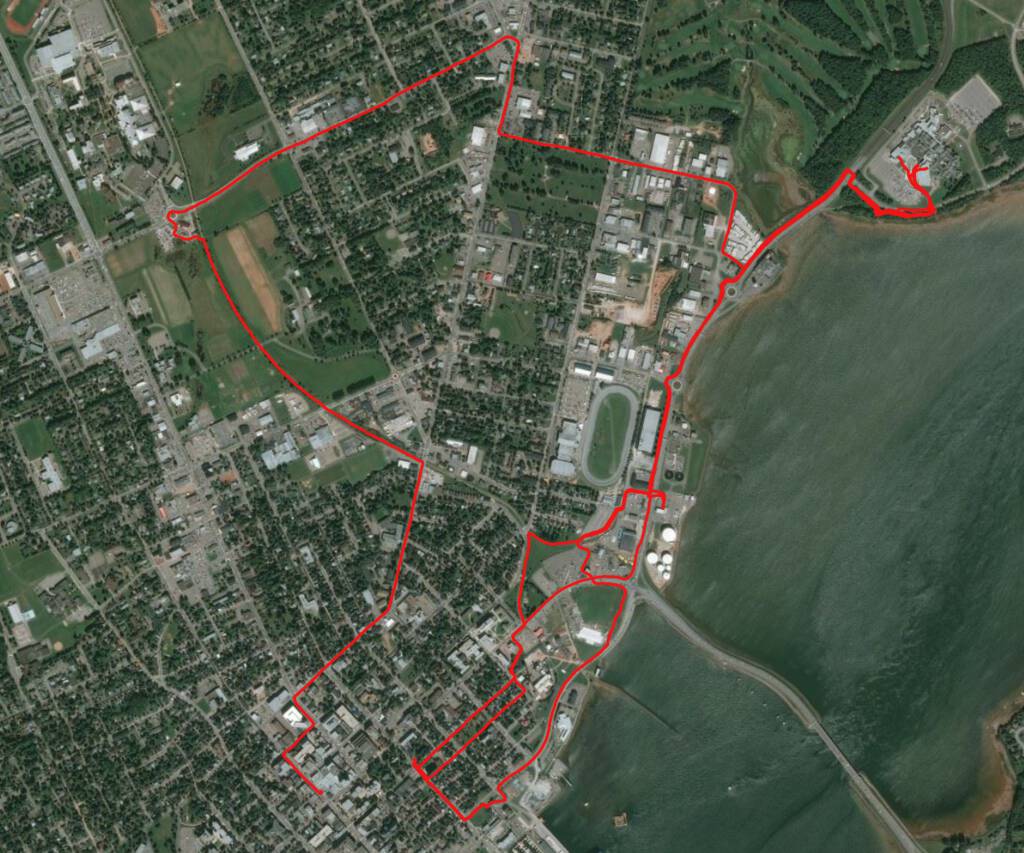
I cycled 30 km yesterday, which included two trips to the Queen Elizabeth Hospital and a trip to the Charlottetown Farmers’ Market from the hospital.
I learned a couple of things along the way:
- It takes 15 minutes to cycle from our house to the hospital. That’s really only a few minutes longer than it takes to drive, and most of the way is along the scenic multi-use trail along Riverside Drive that’s separated from vehicle traffic. The hospital should take advantage of this to encourage visitors to cycle. And if you’re going to visit someone yourself, consider taking your bicycle.
- There appeared to be no provision whatsoever made to the multi-use trail during sewer construction in front of Riverview Country Market on Friday: the trail was blocked, but with no cycle detour, forcing cyclists to cut through the parking lot and navigate uncontrolled construction vehicle traffic. If active transportation is going to become a first class option in Charlottetown, we need to make equal provisions for routing cyclists around construction as we do cars and trucks.
- Taking a water bottle along on cycle trips is a really, really good idea. I’ve never gotten into the habit of doing this, but I will now.
- The cycle lane along Belvedere Avenue from Ellis Brothers to Mount Edward Road is in horrible shape, the result of several construction projects that degraded it. This is a shame because otherwise it’s a great cycle route: lots of room on a broad shoulder, and a great east-west connector across the city.
- It would be nice if we could connect the path that goes around the Charlottetown Event Grounds with the Riverside Drive multi-use trail; as it stands cycling from one to the other requires a detour through the back of the Wendy’s parking lot.
- The Irving Gas Station on Riverside Drive charges $1 for using its air pump. Huh?
- The bicycle parking lot at the Charlottetown Farmers’ Market is very well used. Indeed, there’s a need for more bicycle parking there, as it was full when I arrived.
I’ll bring forward many of these issues to the Mayor’s Task Force on Active Transportation; if experience so far is any guide, the city will take quick action to address them.
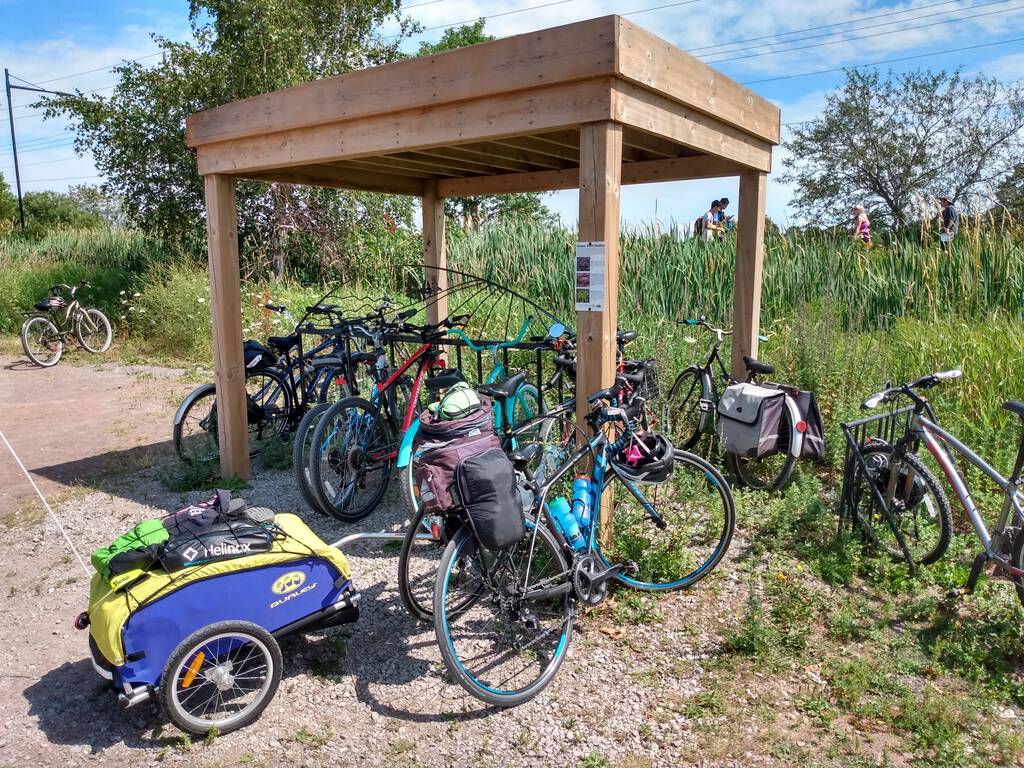
The (full) Bicycle Parking Lot at Charlottetown Farmer’s Market
My friend G. was unable to find replacement plastic clips that hold a window screen in place, so I offered to fabricate some on my 3D printer.
I made the model in Tinkercad; the hardest part to figure out was how to make the short edges rounded.
As 3D models go they were super-quick to print, at about 8 minutes each
On the left is the original that I worked from; in the middle is my first attempt, and on the right is my second.

 I am
I am